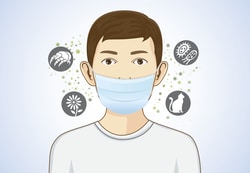Like so many parts of our body, our sinuses usually go unnoticed by us until a problem develops. Fortunately, for many of us, that’s not too often. That in itself is amazing, considering how complex and multi-functional our sinuses are. When I was a kid, I imagined that the pathway from my nostrils to my windpipe was one straightforward tube, like a snorkel. It seemed to me that it served very little purpose–especially since I had a perfectly good mouth with which to breathe through. On further inspection, it’s easy to see that the sinuses are so much more.

Comprised of four paired regions (yes, we have eight sinus cavities), the paranasal sinuses are located between the eyes, above the eyes, on either side of the nostrils, and behind the eyes in the deep recesses of our skull. Among the many purposes they serve are:
- Host to our sense of smell.
- Filters out moisture and foreign particles.
- Provides resonance to our voices.
- Lightens the overall weight of the skull.
Our sinuses are largely self-maintaining, but issues can develop especially during cold and allergy season. Irritants, allergens, and pathogens can cause the sinus to respond by producing excess mucus and swelling. Such a condition is referred to as sinusitis. This condition, if left unchecked, can become chronic and result in severe headache, nausea, and a propensity to recur. Measures to combat such conditions can include the taking of antihistamines, decongestants, and nasal irrigation. In severe instances antibiotics may be needed to fight infection.*

Although our sinuses are pretty good at taking care of themselves, we still need to take measures to protect them. Limiting exposure to allergens and irritants, whenever possible, can help us avoid stressing our sinuses. The mucous membranes present in our sinuses are composed of tissue called epithelium, that not only secretes matter, but absorbs it as well. This means that our mucous membranes can act as a doorway to our internal system. Bacteria, viruses, fungi, and other pathogens can make their way in through our sinuses.
That being the case, to put it bluntly; we want to be careful of what we put up our nose. Basic hygiene fundamentals, like hand-washing, can go a long way in protecting our sinuses. If it becomes necessary to insert anything into the nostrils, like an oxygen cannula, care should be taken to see that such objects are properly sanitized.
Sinus problems can rate up there with toothaches and earaches, as far as pain-level and discomfort. Fortunately, a little preventive care can help us to avoid such problems. Our sinuses deserve nothing less, after all, it’s eight against one.
*SoClean does not endorse any particular treatment.




